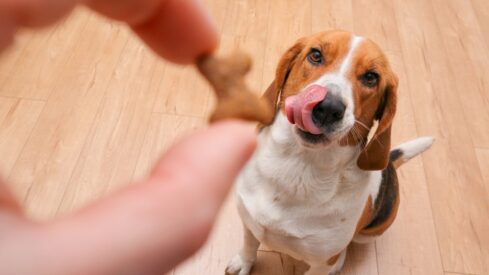Snack attack: the impacts of calories in treats

Snacking products represent the fastest-growing segment in the pet food market – but do they come at a cost to pet health?
As a reward for training, something to provide distraction, a token of affection or a between-meal treat, snacks have become indispensable additions to product ranges for dogs and cats, and come in various forms, sizes and compositions.
A booming market
Currently, the European pet snacks and treats market size is valued at $7.6 billion (€6.8B) and is expected to grow annually by 11.3% until 2030.
Unlike with their pets’ main diet, where pet owners tend to be brand-loyal, there is a strong consumer readiness to explore the entire range of snacks.
For chewing articles for dogs, owners frequently switch between pig ears, bully sticks, chew bones and similar long-lasting snacks.
Since training should always be exciting and rewards appealing, countless types of handy treats are available.
A token of affection should be something special – and varied. Clever marketing strategies are used to help products stand out from their competitors and make pet owners feel good.
Superficially, many snacks suggest that they are healthy and even that they provide extra benefits for the beloved pet: good for skin and coat, providing extra vitamins and being high in protein are just a few examples of the colorful claims found on snack packaging.
Not only do they seem like guilt-free treats, but it also feels like they could be contributing to a pet’s health.
However, a closer look at the packaging often reveals that the ingredients touted for their benefits are only present in minimal amounts, such as would require a pet to consume exorbitant quantities of the snacks to achieve the marketed effect.
And from a nutritionist’s point of view, snacks are one thing above all: an extra portion of calories.
Caloric calculations
Conscientious pet owners will weigh snacks and reduce their pets’ daily food portion accordingly.
However, it is often forgotten that different feeds have varying nutrient densities – 100 g of wet food cannot simply be swapped for 100 g of dried pig ear. A typical pig ear weighs 40-50 g and contains 466 kcal per 100 g.
A 10 kg dog with a normal activity level needs about 550 kcal per day, so feeding just one pig ear provides 41% of the dog’s daily caloric intake.
An example premium wet food contains about 100 kcal per 100 g, meaning the same 10 kg dog would need about 550 g of this food per day.
To balance out the calories from one pig ear, the wet food portion would need to be reduced by 200-230 g, not just 40-50 g (the weight of the pig ear).
And what are the consequences of more or less uncontrolled snack feeding?
When snacks are given in addition to the daily food amount without reducing it, calorie intake increases. Just like in humans, there are active pets for whom a bit more energy intake doesn’t matter. For others, every treat shows up on the scale.
Health beyond calories
Snacks are considered supplementary feed (which do not constitute a complete diet on their own) or single compound feed (consisting of just one ingredient).
They are not balanced or fully vitaminized complete feeds. It’s often unclear what exactly is being added to the diet with a snack because few treat items have a complete analysis, as these are complex, costly and rarely invested in.
Feeding snacks while reducing the food portion is sensible regarding calorie intake but not with regard to a balanced diet: generally, snacks are not designed to be balanced.
This means that reducing the amount of complete food also reduces the intake of vitamins and trace and macro elements, which are not compensated by giving a snack.
Rather, snacks upset the balance: for example, feeding a bone can significantly increase calcium intake and snack items with a high meat content increase phosphorus intake.
Other important factors should be considered. One is the use of feed additives, which can impose intake limitations due to mandated maximum limits.
For example, potassium sorbate – a common additive in semi-moist treats – now has a regulated maximum quantity and must be declared on packaging.
Achieving balance
What can snack manufacturers do to stand out from the flood of marketing claims with honest, authentic and truly pet-appropriate statements? The answer is to develop snacks with the same care as well-thought-out complete feeds.
Of course, this means greater effort in recipe development, raw material procurement and the complexity of the necessary ingredients, but it doesn’t have to be the use of a completely balanced premix with a life-stage approach.
If the ‘Big 5’ analytical values fit the general nutritional profile of the pet and attention is paid to a balanced calcium-phosphorus ratio, a big step towards the needed extra mile is already taken.
We can also conclude that common feeding recommendations such as “feed snacks up to a maximum of 20% of the daily food ration” are not optimal.
More details should be provided to the consumer and nutrient levels of snacks should be carefully included in well-calculated feeding guidelines. This approach will help pets stay healthy and avoid obesity, a significant challenge for pets today.
If manufacturers then ensure that only species-appropriate ingredients are used, the path to a healthy snack is set.
Let’s hope we will be able to find more balanced, healthy treats with sensible feeding recommendations in the future. Pet owners will surely appreciate them and be ready to trust these products.
